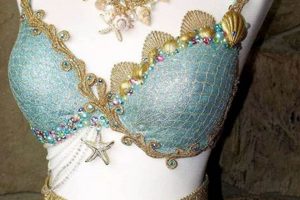Creating a gastropod-themed garment offers an avenue for imaginative self-expression, often involving readily available materials and simple construction techniques. An example includes utilizing cardboard, fabric, and basic crafting supplies to construct a spiraled shell and accompanying attire suggestive of the slow-moving invertebrate.
The practice of fabricating such wearables provides opportunities for creative problem-solving, resourcefulness, and the development of handcrafting skills. Historically, homemade attire has served as a cost-effective and personalized alternative to commercially produced items, fostering individuality and resource conservation. The activity encourages engagement with art and design principles in a practical and accessible manner.
The following sections will detail specific approaches to constructing a gastropod-inspired ensemble, outlining material options, construction methods, and techniques for achieving a visually compelling and functional result.
Fabrication Guidance for Gastropod-Inspired Attire
The creation of a gastropod-themed garment requires careful consideration of materials, construction techniques, and safety protocols to ensure a durable, visually appealing, and functional outcome.
Tip 1: Shell Structure Reinforcement: When employing cardboard for the shell’s substructure, implement internal supports utilizing additional cardboard strips or wooden dowels. This measure prevents collapse or deformation during wear.
Tip 2: Fabric Selection for Durability: Choose robust fabrics such as felt or canvas for the shell covering to withstand repeated use and minimize tearing or abrasion. Consider weather-resistant options for outdoor applications.
Tip 3: Securing the Shell: Employ a harness system constructed from adjustable straps and buckles to distribute the shell’s weight evenly across the wearer’s shoulders and torso. Ensure the harness is securely attached to the shell using rivets or reinforced stitching.
Tip 4: Antenna Construction and Safety: When fabricating antennae, utilize flexible yet sturdy materials such as wire or plastic tubing. Cap the ends with soft materials to prevent accidental injury. Securely attach the antennae to a headband or helmet to maintain stability.
Tip 5: Minimizing Trip Hazards: Design the garment’s length to avoid impeding the wearer’s movement. Ensure sufficient clearance between the lower edge of the shell and the ground to prevent tripping.
Tip 6: Ventilation Considerations: If the design incorporates a fully enclosed shell, integrate ventilation openings to prevent overheating and ensure adequate airflow for the wearer.
Tip 7: Color Fastness: Prior to assembly, test fabric dyes for colorfastness by washing a small sample. This prevents dye bleeding and potential staining of other materials or the wearer’s skin.
Proper planning and execution during the fabrication process will yield a long-lasting and enjoyable gastropod-inspired garment.
The subsequent section will explore advanced design considerations and techniques for achieving a professional-grade result.
1. Material Selection
Material selection is a critical determinant in the successful execution of a do-it-yourself gastropod costume. The chosen substances dictate structural integrity, aesthetic appeal, and overall wearer comfort and safety.
- Shell Substructure Composition
The shell’s underlying framework can be constructed from various materials, each possessing distinct attributes. Cardboard, readily available and cost-effective, provides a lightweight base but may lack durability. Foam, while offering superior impact resistance and moldability, generally incurs higher expense. Wire mesh offers significant structural strength with a limited weight penalty, but it requires specialized tools for manipulation and presents potential safety hazards if improperly handled. The selection hinges on balancing these factors to achieve a stable, yet manageable, form.
- Outer Shell Covering
The outer layer of the shell provides the visual texture and color. Fabric options such as felt, fleece, or canvas offer varied degrees of durability, texture, and water resistance. Paint applied directly to the substructure can achieve specific visual effects but may be susceptible to chipping or fading. Adhesives must be carefully considered to ensure compatibility with both the substructure and outer covering, preventing delamination over time.
- Harness and Attachment Components
The materials used for the harness and attachment points influence the costume’s wearability and safety. Straps crafted from webbing or durable fabric distribute the shell’s weight across the wearer’s body. Buckles and fasteners made of metal or high-strength plastic ensure secure attachment and adjustability. Inadequate material selection for these components can lead to discomfort, slippage, or even complete failure of the costume during use.
- Antenna Construction Elements
The antennae, a prominent feature of the gastropod representation, demand careful material consideration. Flexible wire or tubing forms the core structure, allowing for realistic movement. Soft, padded tips minimize the risk of injury. Lightweight fabrics or foams create the antenna’s outer covering. The chosen materials must be both pliable and durable to withstand repeated bending and potential impacts.
The careful assessment and selection of appropriate materials are paramount to the creation of a successful do-it-yourself gastropod costume, balancing aesthetic requirements with structural integrity, wearer comfort, and budgetary constraints. Furthermore, material attributes need consideration concerning safety and longevity of the final product.
2. Shell Construction
The creation of a recognizable gastropod-themed garment is fundamentally dependent on the fabrication of a shell. As a dominant visual element, the shell dictates the costume’s overall shape and perceived realism. The method of construction directly impacts the costume’s weight, durability, and wearer mobility. For instance, a shell constructed from lightweight foam, while easily maneuverable, may lack the structural integrity of a cardboard or wire-framed shell. Conversely, a robust but heavy shell may impede movement and cause wearer fatigue. The choice of materials and construction techniques, therefore, becomes a critical determinant of the costume’s practicality and aesthetic success.
Different construction approaches yield varying results. A spiraled cardboard form, while economical, requires careful shaping and reinforcement to prevent collapse. A fabric-covered wire frame allows for complex curves and a lighter overall weight, but necessitates specialized tools and sk
ills. Inflatables present a unique option, offering a lightweight and visually striking shell; however, they require a continuous power source for inflation and are susceptible to puncture. Real-world examples include parade costumes, theatrical productions, and amateur crafting projects, each demonstrating a diverse range of shell construction techniques tailored to specific needs and resources. A child’s costume might prioritize lightweight, flexible materials and simplified construction, while a professional stage production could necessitate complex geometries and durable materials capable of withstanding repeated use.
The process of shell construction is not without its challenges. Maintaining a consistent spiral shape, ensuring structural stability, and integrating the shell seamlessly with the harness or wearer’s body are all significant hurdles. A well-constructed shell should distribute weight evenly, allow for a reasonable range of motion, and withstand the rigors of wear. In summary, the success of a homemade gastropod garment hinges on the effective execution of shell construction, balancing material properties, fabrication techniques, and ergonomic considerations to achieve a visually compelling and functional result. This understanding provides a foundation for addressing broader costume design principles related to comfort, safety, and artistic expression.
3. Harness Design
Harness design constitutes a crucial element within the domain of homemade gastropod attire. The primary function of the harness is to support and distribute the weight of the shell, thereby influencing wearer comfort and mobility. A poorly designed harness can lead to discomfort, restricted movement, and potential injury. Consider a scenario where a large, cardboard-based shell is attached via thin, non-adjustable straps. The weight of the shell concentrates on the wearer’s shoulders, leading to strain and limiting arm movement. In contrast, a well-engineered harness incorporates padded shoulder straps, an adjustable waistband, and a secure attachment system, distributing the weight across the torso and allowing for a greater range of motion. Therefore, harness design is not merely an ancillary consideration but an integral aspect of constructing a functional and wearable gastropod-themed costume.
Practical application of sound harness design principles involves several factors. Load distribution is paramount; the harness should evenly distribute the weight across the shoulders, back, and torso to minimize strain on any single point. Adjustability allows for a customized fit, accommodating varying body sizes and shapes. Attachment points connecting the harness to the shell must be robust and secure, preventing detachment during movement. An example of this can be seen in professional mascot costumes, which often feature elaborate internal harness systems designed for extended wear and vigorous activity. The effectiveness of any harness design can be tested using load-bearing tests and mobility assessments. For example, performing a series of movements while wearing the costume, such as walking, bending, and reaching, can reveal potential weaknesses or areas of discomfort in the harness system.
In summary, the relationship between harness design and successful gastropod-inspired garment fabrication is undeniable. An inadequate harness compromises comfort and functionality, whereas a well-designed harness enhances the wearer’s experience and the costume’s overall effectiveness. The challenges of harness design often involve balancing weight distribution, adjustability, and attachment security. This understanding extends beyond mere costume construction, informing principles applicable to load-bearing equipment design and ergonomic considerations in various fields.
4. Mobility Constraints
The creation of gastropod-themed attire presents inherent challenges pertaining to movement restriction. The design process must account for the limitations imposed by the costume’s bulk and structure, influencing both the wearer’s safety and the overall aesthetic impression.
- Shell Size and Weight
The dimensions and mass of the constructed shell directly impact ambulatory capabilities. A large, unwieldy shell restricts limb movement and increases the risk of falls. Examples include parade costumes with oversized elements that require multiple individuals for maneuvering. In the context of self-made gastropod garments, a balance must be struck between visual impact and practical mobility.
- Gait Alteration
The costumes design frequently necessitates an altered gait. The shape of the shell, particularly if it extends beyond the wearer’s center of gravity, forces compensatory adjustments in posture and stride. This can lead to discomfort and fatigue over extended periods. Considerations for weight distribution and streamlined design are crucial to mitigate this effect.
- Visibility Impairment
The shell can obstruct the wearer’s field of vision, creating potential hazards. Peripheral vision is often compromised, increasing the risk of collisions with surrounding objects or individuals. Design solutions include incorporating viewing ports or utilizing translucent materials in strategic locations. Examples exist in industrial safety gear, where visibility is paramount.
- Environmental Interaction
The costume’s form dictates its interaction with the environment. Navigating doorways, ascending stairs, and maneuvering through crowded spaces become challenging. This is particularly relevant for costumes intended for outdoor events or performances. Adaptations, such as collapsible or removable shell segments, can improve practicality.
These mobility constraints are intrinsic to the design of gastropod-inspired garments. Effective mitigation strategies involve careful consideration of material selection, structural design, and ergonomic factors. Ultimately, the success of a do-it-yourself gastropod ensemble hinges on achieving a compromise between visual representation and functional mobility.
5. Antenna Stability
Within the scope of homemade gastropod attire, antenna stability represents a crucial design consideration. The antennae, often prominent features of such costumes, are vulnerable to instability due to their extended length and relatively slender structure. A lack of structural integrity results in drooping, swaying, or even breakage, detracting from the overall aesthetic and potentially posing a safety hazard to the wearer and those nearby. For instance, consider a costume employing wire antennae covered only with thin fabric; the unsupported weight of the fabric leads to immediate sagging, compromising the intended visual effect. Therefore, achieving adequate antenna stability is directly linked to the perceived quality and functionality of the gastropod costume.
Practical applications of antenna stabilization techniques vary. Internal supports, such as rigid rods or flexible tubing, can provide the necessary reinforcement to maintain the desired antenna shape. Secure attachment mechanisms, including reinforced bases and robust fastening systems, prevent detachment or exces
sive movement. Furthermore, material selection plays a significant role; lighter materials reduce the overall weight of the antennae, minimizing stress on the supporting structure. An example of effective antenna stabilization is found in professionally crafted mascot costumes, where intricate internal frameworks and durable materials ensure the antennae remain upright and secure despite rigorous activity. The absence of such considerations in amateur efforts often results in aesthetically compromised and structurally unsound antennae.
In summary, antenna stability is not merely a superficial detail in the creation of homemade gastropod costumes; it is a fundamental engineering challenge. Effective stabilization techniques, encompassing structural reinforcement, secure attachment, and appropriate material selection, are essential for achieving a visually appealing, durable, and safe final product. Neglecting this aspect leads to aesthetic deficiencies and potential safety risks, underscoring the importance of integrating antenna stability considerations into the early stages of the design process.
6. Weight Distribution
Weight distribution is a critical factor in the successful design and construction of a gastropod-themed garment. An uneven distribution of mass can result in discomfort, fatigue, and impaired mobility for the wearer. The primary component of such a costume, the shell, often contributes significantly to the overall weight. Consequently, the method by which this weight is supported and dispersed across the wearer’s body directly influences the costume’s functionality and wearability. If the shell’s weight is concentrated on a single point, such as the shoulders, it can lead to strain and restricted movement. Conversely, a well-designed harness system distributes the load across a broader area, minimizing localized pressure and enhancing comfort. A practical example of this principle is evident in professional mascot costumes, where elaborate internal support structures are employed to ensure even weight distribution, enabling performers to maintain mobility and stamina over extended periods.
Effective weight distribution in a homemade gastropod-inspired ensemble requires careful consideration of materials, construction techniques, and harness design. The selection of lightweight materials for the shell substructure and outer covering minimizes the overall load. Internal supports and reinforcement strategically placed within the shell contribute to structural integrity without adding excessive weight. The harness system should incorporate padded shoulder straps, an adjustable waistband, and secure attachment points to distribute the weight evenly across the torso. Furthermore, the positioning of the shell relative to the wearer’s center of gravity impacts stability and balance. Moving the shell closer to the body’s center of mass reduces the lever arm effect and minimizes the effort required to maintain equilibrium. This principle is exemplified in backpack design, where heavy items are positioned closer to the wearer’s back to improve balance and reduce strain.
In conclusion, the successful creation of a functional and comfortable gastropod-themed costume hinges on a thorough understanding and effective implementation of weight distribution principles. Neglecting this aspect can result in a cumbersome and impractical garment, limiting the wearer’s mobility and enjoyment. The challenges associated with weight distribution underscore the importance of careful planning, material selection, and harness design. This understanding is applicable not only to costume construction but also to a broader range of design challenges involving load-bearing structures and ergonomic considerations, emphasizing the practical significance of these principles.
7. Cost Optimization
Cost optimization, in the context of gastropod-themed attire fabrication, directly influences material selection, construction techniques, and overall design complexity. Budgetary constraints frequently necessitate the prioritization of readily available and inexpensive materials such as cardboard, fabric remnants, and recycled items. This emphasis on cost-effectiveness can limit design options and necessitate innovative problem-solving to achieve a visually acceptable outcome. The practical effect is a trade-off between aesthetic ambition and budgetary limitations. For example, a professional costume designer might employ expensive, lightweight materials and intricate construction methods to achieve a hyper-realistic effect. Conversely, a cost-optimized DIY approach might rely on simpler shapes, readily available supplies, and fundamental construction techniques, impacting the final product’s level of detail and realism. The importance of cost optimization lies in enabling broader participation in creative expression, democratizing access to costume design beyond professional or commercially available options. Failure to consider cost limitations early in the design phase can lead to project abandonment due to unsustainable resource allocation.
Further analysis reveals that cost-optimized DIY methods frequently foster resourcefulness and ingenuity. Individuals often repurpose existing materials, reducing waste and minimizing environmental impact. Examples include utilizing old clothing for fabric components, transforming discarded containers into structural elements, and employing salvaged hardware for fastening systems. This approach not only lowers costs but also promotes a more sustainable and environmentally conscious creative practice. However, the long-term durability and safety of such costumes must be carefully considered. The use of untested or inappropriate materials can compromise structural integrity or pose risks to the wearer. Therefore, a balanced approach is essential, prioritizing both cost-effectiveness and safety considerations. Practical applications extend to educational settings, where DIY costume projects can teach valuable lessons about resource management, creative problem-solving, and sustainable practices.
In summary, cost optimization is an intrinsic component of the gastropod-themed attire fabrication process. It dictates material choices, construction methods, and design complexity, impacting both the final product’s aesthetic and its practical suitability. Challenges associated with cost optimization include balancing budgetary limitations with safety concerns and aesthetic aspirations. However, the process also fosters resourcefulness, creativity, and a more sustainable approach to costume design. Understanding the interplay between cost optimization and DIY costume creation allows for a more informed and pragmatic approach to this creative endeavor. This understanding extends to other areas where frugality and creative designs meets.
Frequently Asked Questions
This section addresses common inquiries concerning the construction of gastropod-inspired garments, providing concise and informative responses to frequently encountered questions.
Question 1: What materials offer the optimal balance of cost, weight, and durability for shell construction?
Expanded polystyrene (EPS) foam offers a favorable compromise between cost, weight, and durability for shell construction. Cardboard provides a more economical option, albeit with reduced durability and increased weight. Wire mesh offers superior structural strength but may present challenges in terms of cost and ease of manipulation.
A properly designed harness system is crucial for distributing the shell’s weight. The harness should incorporate padded shoulder straps, an adjustable waistband, and secure attachment points to evenly distribute the load across the wearer’s torso. Adjustability is essential to accommodate varying body sizes and shapes.
Question 3: What safety precautions should be observed when fabricating antennae for a gastropod-themed garment?
Antennae should be constructed from flexible yet durable materials. Sharp edges should be eliminated by capping the ends with soft materials. Secure attachment to a headband or helmet is necessary to prevent detachment and potential injury. The antennae should not obstruct the wearer’s vision or pose a tripping hazard.
Question 4: How can the design of a gastropod-themed costume address potential mobility limitations imposed by the shell?
Minimizing the shell’s size and weight is paramount. The design should allow for a reasonable range of motion in the arms and legs. The lower edge of the shell should provide sufficient clearance to prevent tripping. Consider incorporating articulated or removable shell segments to improve maneuverability.
Question 5: What are the key considerations for ensuring adequate ventilation within a fully enclosed gastropod shell?
Ventilation openings should be strategically positioned to promote airflow. Multiple openings, both at the top and bottom of the shell, are recommended. The size and number of openings should be adjusted based on the shell’s volume and the anticipated level of activity. The openings should be screened to prevent the ingress of debris or insects.
Question 6: How can the use of recycled or repurposed materials contribute to cost optimization in gastropod-themed attire fabrication?
Repurposing existing materials reduces the need to purchase new supplies. Fabric remnants can be used for the shell covering. Cardboard boxes can be transformed into structural elements. Discarded containers can be repurposed for smaller details or embellishments. However, the structural integrity and safety of recycled materials must be carefully assessed prior to use.
These responses provide a foundation for addressing common challenges encountered during the construction of gastropod-inspired garments, emphasizing the importance of safety, functionality, and cost-effectiveness.
The subsequent section will delve into advanced techniques for achieving a professional-grade gastropod costume.
Concluding Remarks on Snail Costume DIY
The preceding exploration of “snail costume diy” has detailed various aspects, from material selection and shell construction to harness design, mobility constraints, antenna stability, weight distribution, and cost optimization. These elements, when carefully considered and implemented, directly influence the overall quality, functionality, and aesthetic appeal of the final product. The act of creating such a costume, while seemingly simple, necessitates a holistic understanding of design principles and practical construction techniques.
The fabrication of gastropod-inspired attire represents a confluence of artistic expression, engineering considerations, and resource management. Further investigation and refinement of these techniques have the potential to yield more durable, comfortable, and visually compelling results, fostering a greater appreciation for the creative possibilities inherent in do-it-yourself craftsmanship. Future endeavors in this domain should prioritize safety, sustainability, and the pursuit of innovative design solutions.







